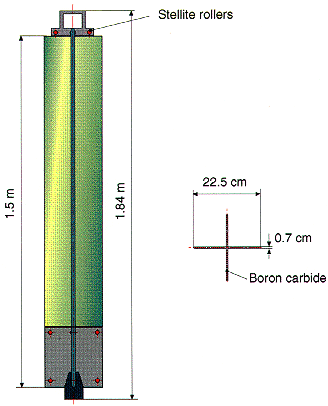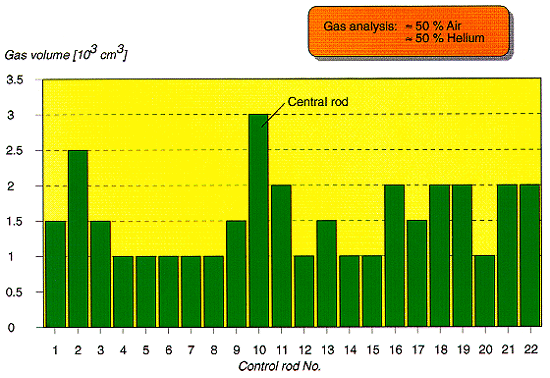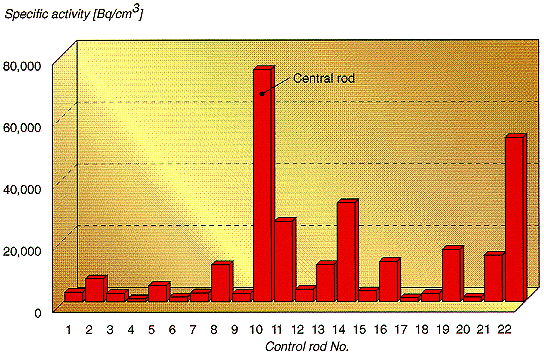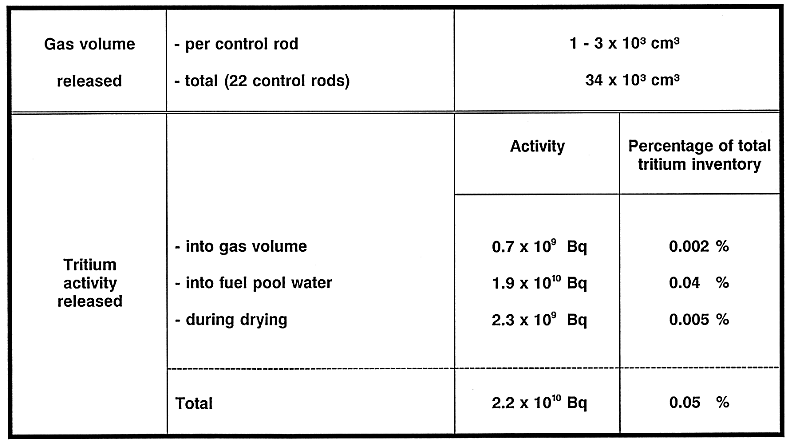
Fig. 1. VAK-control rod.
Klaus Springer
Ministry of Environmental Affairs
Munich
Dietrich Mertin
RWE Energie AG
Essen
Christoph Lierse
Technical University
Munich
ABSTRACT
The control rods of BWRs consist of stainless steel tubes filled with vibrocompacted boron carbide (B4C). In order to dispose of irradiated control rods, it is necessary to cut them into small pieces. Of significant interest is the release of tritium during the shearing process in the fuel storage pool and during further processing.
An extensive measurement programme carried out during the treatment of 22 highly irradiated control rods of the Kahl nuclear power plant (VAK) proved that only a very small portion of the total tritium inventory (less than 0.1%) was released during on-site shearing, packaging and drying. From the radiological and environmental point of view this procedure is feasible without reservation.
This experience is taken as a basis for the disposal of 100 control rods of the Gundremmingen nuclear power plant, unit A (KRB A).
INTRODUCTION
The Kahl nuclear power plant (Versuchsatomkraftwerk Kahl - VAK) was the first NPP in Germany at all. With a BWR of 16 MWel designed by GE, it was operated from 1960 to 1985. Dismantling has been in progress for about 10 years. Vibrocompacted B4C powder clad in stainless-steel tubes was used as neutron-absorbing material in the control rods. The design is almost identical to the design of most modern BWRs (Fig. 1).

Fig. 1. VAK-control rod.
Stainless steel was used as material for the cruciform components and tubes. Pins and rollers were made of stellite with a high cobalt content. With an active length of approx. 1.5 m, each control rod contained approx. 3.4 kg of boron carbide in the tubes. In order to prevent the boron carbide in the columns from condensing, globules maintaining subdivisions had been pressed into the columns.
After being irradiated for 25 years of operation in the NPP the 22 control rods had to be cut into small pieces to be packed into final storage containers. For this purpose, a special underwater shearing device ("underwater shear compactor", USC) was used in the storage pool.
The main point of interest was the behaviour of tritium during shearing andpackaging of the control rods and during vacuum drying of the loaded containers. At VAK, a detailed measurement programme was implemented in order to determine the amount of tritium released into water and air.
DISPOSAL STEPS
Like other radioactive waste control rods have to be transported first to an intermediate storage facility and later on to a repository. The intermediate and final storage conditions have to be observed. Since the control rods cannot be stored in entire length it was necessary to cut them into segments, which had to be packed into cast-steel containers with a wall thickness of 15 cm and additional lead shielding in order to meet the storage conditions.
The pool at VAK was a suitable location for shearing the control rods. The following disposal steps had to be carried out:
Before shearing the control rods the stellite rollers had to be removed and packed separately because of their extremely high activity and dose rate.
TRITIUM CONDITIONS
Tritium is produced in B4C control rods by the nuclear reactions
105B (n, 2![]() ) 31H
and 105B (n, 2
) 31H
and 105B (n, 2![]() ) 73Li
(n, n
) 73Li
(n, n![]() )
31H.
)
31H.
The tritium inventory of a VAK control rod was calculated to be 3 x 1012 Bq. A hot cell post-irradiation examination of a highly exposed control rod of the KRB A reactor showed that all the tritium produced is bound to the B4C powder [1]. These laboratory measurements, however, did not give any information about the release mechanism during underwater shearing.
Due to the missing of empirical data the project was first picked up with reservations, because significant radiological problems could not be excluded.
Therefore, a worst-case scenario with the most unfavourable conditions was examined. It was assumed that the amount of tritium calculated would be released directly into the air or via the pool water. It was calculated that in all cases the radiation exposure of personnel and the tritium emission via the stack and waste water would fall well below the respective limits.
Discussions between the operator of VAK and the supervising authority which had to approve the entire project according to the decommissioning licence, finally led to a step-by-step procedure:
Thus, it was ensured that inadmissable radiation exposures or emissions could not occur.
TRITIUM MEASUREMENT PROGRAMME
The measurement programme covered all possible release paths of tritium into air and waste water.For observing and collecting all gas bubbles and takingthe necessary samples during shearing, a gas collection device (plexiglass hood) was built which could be located under water above the shaft of the underwater shear compactor.

Fig. 2. Underwater shear compactor
and gas analysis.
Three parallel methods were applied to determine the tritium concentration in the gas:
Major errors in the analysis can be ruled out due to the use of these three independent measurement methods.
During shearing, the mobile gas flow counter was also used to directly monitor the room air. For this purpose, the air above the pool was collected by means of a tube.
The tritium in the pool water was analysed by taking regular samples.
Finally, a device was developed to collect and analyze the exhaust air from the cast-steel containers during drying.
The different measurement techniques were coordinated in detail with the competent expert and authority.
IMPLEMENTATION OF CONTROL ROD SHEARING
An underwater shear compactor (USC) was bought for the dismantling of the core components and also for the shearing of the control rods.
It mainly consists of a compacting and a shearing unit with lead-in shaft, a collecting chamber with a double filter system and a mobile stainless steel basket for collecting the cut pieces.
After putting a control rod into the compactor shaft, the gas collection hood was placed directly above the inlet. At the beginning, two compaction steps were carried out in the bottom area due to the massive coupling section. The first cut was done in the area of the tubes. The bottom part had a length ofapprox. 30 cm, all other parts 15 cm.
When shearing the tubes a cloud of boron carbide was discharged into the water so that it became muddy and extended waiting periods between the cuts had to be observed. In this context the design of the USC, with its two internal filter systems purifying the pool water, turned out to be very advantageous.
The 22 control rods were packed into a total of nine containers.
RESULTS
After shearing the first control rod a large amount of gas was emitted, bubbling for several minutes. The collection hood successfully absorbed the gas.
The gas volume released was 1,000 - 3,000 cm3 per rod. There was no control rod which did not release any gas. The gas analysis carried out at the Technical University of Munich showed a composition of aprrox. 50% helium due to production and approx. 50% air due to sampling (Fig. 3).

Fig. 3. Gas release from control rods
at VAK.
A correlation between gas volume, boron burn-up and core position can hardly be seen. One reason for this may be previous damage to the metal tubes, evidence of which has been found in other power plants. However, the central rod which had been in regular service over the last three months, predictably showed the largest gas quantity of 3,000 cm3.
The tritium activity concentration of the released gas varies between approx. 1,000 Bq/cm3 and 75,000 Bq/cm3 (Fig. 4). A systematic correlation between activity concentration, gas quantity, burn-up and last core position cannot be identified. However, the most irradiated central rod with the largest gas release also showed the maximum specific activity of 75,000 Bq/cm3. In all cases, the tritium activity released to the gas phase was less than 0.01% of the calculated inventory which was already conservative.

Fig. 4. Tritium release from control
rods at VAK.
The tritium measurements of the pool water showed a slight upward trend from approx. 75 Bq/cm3 to approx. 215 Bq/cm3 over the entire dismantling campaign. It is not possible to distinguish between the portion which was relased from the gas phase and the portion which was possibly transferred directly from the boron carbide to the water. In any case, the pool water contained less than 0.1% of the entire tritium inventory calculated for the control rods.
During drying of the cast-steel containers about 2.3 x 109 Bq tritium were additionally released from the control rod sections. Table I summarizes all results.
TABLE I Summary of Results

SUMMARY
The total volume of gas released during the cutting of a control rod into about 10 pieces was 1,000 to 3,000 cm3 per rod, consisting of helium (approx. 50% of the volume) and normal air. The tritium concentration in the gas ranged between 1,000 Bq/cm3 and 75,000 Bq/cm3. It is almost impossible to establish a correlation between the gas volume or the tritium concentration and the exposure of the rod.
During the whole campaign (22 control rods), the tritium concentration in the pool water increased from 75 to 215 Bq/cm3.
During vacuum drying of the disposal containers, the total tritium release was approx. 2.3 x 109 Bq.
To sum up it can be stated that much less than 0.1% of the tritium inventory in the rods was released during waste processing. Hence, there was no relevant radiological or environmental impact.
REFERENCE